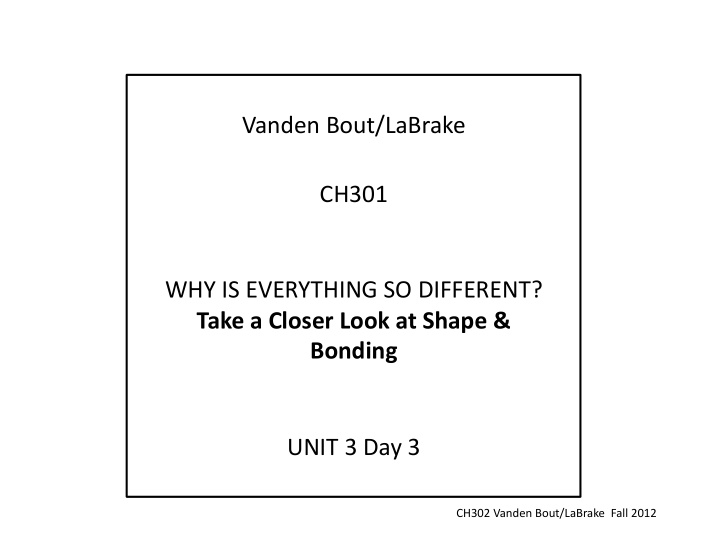



Vanden ¡Bout/LaBrake ¡ CH301 ¡ WHY ¡IS ¡EVERYTHING ¡SO ¡DIFFERENT? Take ¡a ¡Closer ¡Look ¡at ¡Shape ¡& ¡ Bonding ¡ UNIT ¡3 ¡Day ¡3 ¡ CH302 ¡Vanden ¡Bout/LaBrake ¡ ¡Fall ¡2012 ¡
Important ¡InformaJon ¡ UNIT ¡2 ¡EXAM ¡WRAPPER ¡LM ¡Due ¡NEXT ¡TH ¡ LM21 ¡DUE ¡T ¡9AM ¡ HW ¡7 ¡DUE ¡T ¡9AM ¡ ¡ CH302 ¡Vanden ¡Bout/LaBrake ¡ ¡Spring ¡2012 ¡
What ¡are ¡we ¡going ¡to ¡learn ¡today? ¡ Understand & Predict Molecular Polarity Based on Shape � Understand Bonding Theory Supporting Experimentally Determined Shapes (VB Theory - σ and π bonds) � CH302 ¡Vanden ¡Bout/LaBrake ¡ ¡Fall ¡2012 ¡
REVIEW ¡LEARNING ¡MODULE ¡20 ¡
μ ¡ ¡= ¡ ¡Q ¡r ¡ - CH 4 (your) left sector � - NH 3 center sector � - H 2 O � (your) right sector � - Make a model of one of these molecules � - Use different colored clay balls for the different elements in compound � CH302 ¡Vanden ¡Bout/LaBrake ¡ ¡Fall ¡2012 ¡
- Are the bonds polar? � - Are the molecules polar? � - Is there a dipole moment? � Are the questions “Is the molecule polar?” and � � � � � “Is does the molecule have a dipole � � � � � � � moment the same question? � � � � � � � � � � � � the same question? � Have a little moment…. � CH302 ¡Vanden ¡Bout/LaBrake ¡ ¡Fall ¡2012 ¡
left � � � � center � � � right � CH 3 Cl CHCl 3 � � CCl 4 � - Make a model of one of these molecules � - Use different colored clay balls for the different elements in compound � - Are there any polar bonds? � - Are any of the molecules polar? � - Are there a dipole moments? � CH302 ¡Vanden ¡Bout/LaBrake ¡ ¡Fall ¡2012 ¡
Atomic Orbitals Molecular Shape � How is it that we get from atomic orbitals with characteristic shapes to these bonds? � Overlapping orbitals – � H 2 � HF � CH302 ¡Vanden ¡Bout/LaBrake ¡ ¡Fall ¡2012 ¡
Valence ¡Bond ¡Theory ¡(VB) ¡ H-‑H ¡bond, ¡s ¡– ¡s, ¡“head ¡on” ¡ • overlap ¡yields ¡sigma ¡bond ¡ H-‑F ¡bond, ¡s-‑p, ¡“head ¡on” ¡ • overlap ¡yields ¡sigma ¡bond ¡
Think about methane – CH 4 � 2s 2 2p 2 overlapping with 1s 1 � How is that possible? � CH302 ¡Vanden ¡Bout/LaBrake ¡ ¡Fall ¡2012 ¡
Make ¡“new” ¡atomic ¡orbitals ¡that ¡are ¡combinaJons ¡of ¡the ¡“old” ¡orbitals. ¡ We ¡call ¡these ¡“hybrids” ¡ one ¡2s ¡+ ¡three ¡2p’s ¡ ¡ ¡= ¡ ¡ ¡four ¡sp 3 ¡ CH302 ¡Vanden ¡Bout/LaBrake ¡ ¡Fall ¡2012 ¡
NEW ¡HYBRIDIZED ¡ORBITALS ¡ARE ¡DEGENERATE! ¡ CH302 ¡Vanden ¡Bout/LaBrake ¡ ¡Fall ¡2012 ¡
EXPLAIN ¡BONDING ¡FOR ¡AMMONIA ¡ CH302 ¡Vanden ¡Bout/LaBrake ¡ ¡Fall ¡2012 ¡
Use ¡hybridizaJon ¡to ¡explain ¡the ¡trigonal ¡planar ¡arrangement: ¡for ¡ example ¡BF 3 ¡ CH302 ¡Vanden ¡Bout/LaBrake ¡ ¡Fall ¡2012 ¡
When ¡one ¡s ¡and ¡two ¡ p ¡oribitals ¡are ¡mixed ¡to ¡form ¡a ¡ ¡ set ¡of ¡three ¡ sp 2 ¡orbitals, ¡one ¡p ¡orbital ¡remains ¡unchanged ¡and ¡ ¡ is ¡perpendicular ¡to ¡the ¡plane ¡of ¡the ¡hybrid ¡orbitals. ¡ CH302 ¡Vanden ¡Bout/LaBrake ¡ ¡Fall ¡2012 ¡
USE ¡VB ¡THEORY ¡TO ¡EXPLAIN ¡BONDING ¡IN ¡ETHENE ¡ ¡ CH302 ¡Vanden ¡Bout/LaBrake ¡ ¡Fall ¡2012 ¡
VB ¡mulJple ¡bond ¡ Ethene ¡has ¡a ¡C ¡= ¡C ¡ • double ¡bond ¡
LABEL ¡THE ¡SIGMA ¡AND ¡PI ¡BONDS ¡ CH302 ¡Vanden ¡Bout/LaBrake ¡ ¡Fall ¡2012 ¡
USE ¡VB ¡THEORY ¡TO ¡PREDICT ¡BONDING ¡IN ¡ETHYNE ¡ When ¡one ¡s ¡orbital ¡and ¡one ¡ ¡orbital ¡are ¡hybridized, ¡a ¡set ¡of ¡two ¡ sp ¡ orbitals ¡oriented ¡at ¡180 ¡degrees ¡results ¡ two ¡p ¡orbitals ¡“lej ¡over” ¡for ¡making ¡pi ¡bonds. ¡ Examples ¡of ¡sp ¡hybridizaJon: ¡ ¡N 2 , ¡HCCH, ¡CO 2 ¡ CH302 ¡Vanden ¡Bout/LaBrake ¡ ¡Fall ¡2012 ¡
HybridizaJon ¡of ¡orbitals ¡for ¡CO 2 ¡ CH302 ¡Vanden ¡Bout/LaBrake ¡ ¡Fall ¡2012 ¡
(a) ¡An ¡sp ¡hybridized ¡nitrogen ¡atom ¡(b) ¡The ¡s ¡bond ¡in ¡the ¡N 2 ¡molecule ¡ ¡ (c) ¡the ¡two ¡p ¡bonds ¡in ¡N 2 ¡are ¡formed ¡ CH302 ¡Vanden ¡Bout/LaBrake ¡ ¡Fall ¡2012 ¡
HybridizaJon ¡for ¡expanded ¡valence ¡ CH302 ¡Vanden ¡Bout/LaBrake ¡ ¡Fall ¡2012 ¡
WHAT ¡HAVE ¡WE ¡LEARNED ¡TODAY? ¡ Using ¡Molecular ¡Shapes ¡one ¡can ¡predict ¡– ¡ ¡ ¡The ¡polarity ¡of ¡the ¡molecule ¡ The ¡Molecular ¡Shapes ¡can ¡be ¡explained ¡ using ¡the ¡concept ¡ ¡-‑ ¡ ¡ ¡Valence ¡Bond ¡Theory ¡ ¡-‑ ¡Hybridized ¡ Orbitals. ¡ CH302 ¡Vanden ¡Bout/LaBrake ¡ ¡Fall ¡2012 ¡
Learning Outcomes � Apply ¡the ¡VB ¡model ¡to ¡give ¡the ¡atomic ¡hybridizaJon ¡of ¡ ¡ any ¡atom ¡in ¡a ¡given ¡molecule ¡ Use ¡the ¡VB ¡model ¡to ¡describe ¡any ¡bond ¡in ¡a ¡molecule ¡ Determine ¡if ¡a ¡molecule ¡is ¡polar ¡based ¡on ¡polar ¡bonds ¡ and ¡its ¡molecular ¡geometry ¡ CH302 ¡Vanden ¡Bout/LaBrake ¡ ¡Fall ¡2012 ¡
Recommend
More recommend